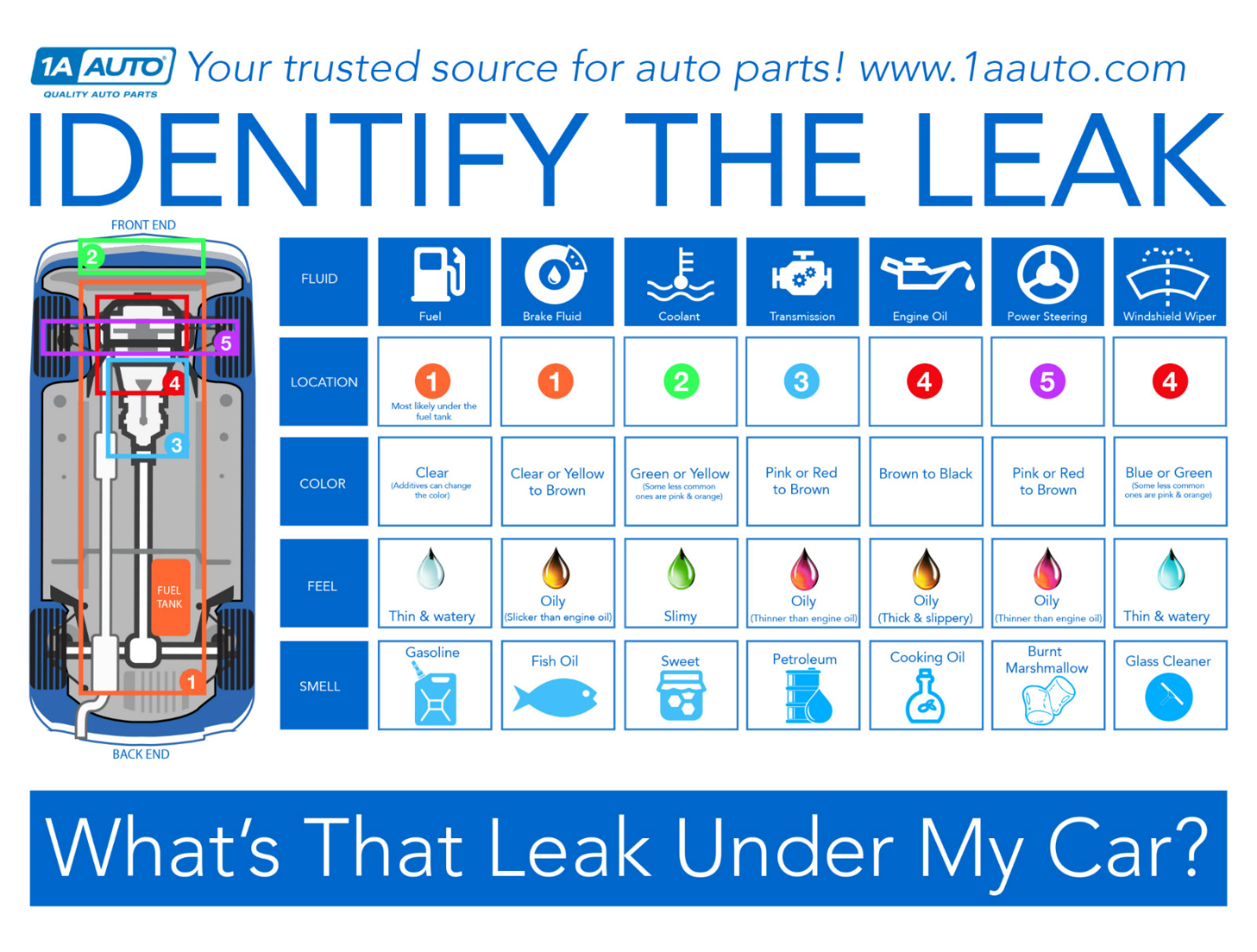What Fluid is Leaking From My Car?
You go out to your car in the morning or at the end of the work day, and there are drops of liquid, or worse yet, a big puddle, underneath it. You wonder what’s leaking and how bad is it? You don’t necessarily need to call a mechanic or have the car towed off the bat. With a little knowledge and some testing you can figure out what the fluid is and what to do about it.
First you’ll want to capture the leaks. It will be hard to get a good look at them on dark pavement, so put down a piece of butcher paper, newspaper, cardboard or aluminum foil underneath your car to catch the leaks. Park the car somewhere flat and level, and weigh down your drip catcher so it doesn’t get blown away by the wind. Once you’ve caught some of the fluid, it’s time to identify it. To do this, you’ll have to use your senses of sight, touch, and maybe even smell.
Identify Where the Leak Is Coming From
The first clue you’re going to use to identify your leak is where it’s coming from. If you have a rear wheel drive vehicle (common for pickup trucks, some sports cars, and most classics), a leak coming from the rear of the car is most likely differential fluid. A leak in the rear could also be coming from the gas tank.
There are a few fluids that could come down from the engine bay. One of these is brake fluid which might tend to leak near the back of the engine bay, where the brake master cylinder is, or along the brake lines. Power steering fluid and coolant are more likely to leak from the front of the engine bay. Oil can leak from throughout the engine bay, but most often tends to leak from the oil pan at the bottom of the engine itself. Windshield wiper fluid will tend to leak around the windshield fluid tank, which can have different locations in the engine bay, depending on what model of car you have.
The transmission is usually located behind the engine so a leak at the back of the engine bay or slightly behind it could be transmission fluid. Water dripping off the air-conditioning evaporator will also land around the middle of the car.
What Color Is the Leaking Fluid?
Next, take a look at what color your leak is. Different fluids have different colors, which can be a big help in identifying your leak.
Brown or Black Fluid Leaking
Oil starts off brown, but tends toward black as it ages.
Pink, Red, or Brown Fluid Leaking
Both power steering fluid and transmission fluid start off as pink or red, but can turn brown with age.
Clear, Yellow, or Brown Fluid Leaking
Brake fluid starts off clear or yellow, but again, can turn brown over time.
Yellow, Green, Pink, or Orange Fluid Leaking
Coolant can vary in color, but is usually yellow or green. Less commonly, some coolants are pink or orange.
Blue, Green, Pink, or Orange Fluid Leaking
Windshield washer fluid is usually blue or green, but is sometimes pink or orange.
Clear Fluid Leaking
Gasoline itself is clear, but additives and dyes can make it any number of different colors. Color isn’t really your best strategy in identifying a gasoline leak.
What Does the Leaking Liquid Feel Like?
The next thing you’ll want to do is pick up some of the fluid with your fingers. You might want to wear gloves when you do this.
Oily Fluid Leaking
If you change your own oil, you might have some idea what consistency engine oil has. It’s, well, oily. Transmission fluid and power steering fluid are also oily, but thinner than engine oil. Differential fluid can be thicker than engine oil.
Slippery and Slimy Fluid Leaking
Brake fluid is even more slippery than engine oil and coolant is downright slimy.
Thin and Watery Fluid Leaking
Gasoline and windshield fluid are thin and watery (as is, of course, water).
What Does the Leaking Fluid Smell Like?
A couple of fluids have distinct smells you can use to identify them. No need to stick your nose right in it, just take a little whiff of what’s on your glove.
Gas Smell
You’re probably well familiar with the sharp, stinging smell of gasoline. Transmission fluid is petroleum based, and so also might smell slightly like gas.
Cooking Oil Smell
The smell of engine oil might be most similar to cooking oil.
Fish Oil Smell
Brake fluid can smell slightly fishy – think of fish oil.
Sweet, Maple Syrup Smell
Coolant tends to smell sweet, almost like maple syrup. That’s why it’s especially important to clean up coolant leaks if you have pets or small children.
Sweet, Burnt Marshmellow Smell
Power steering fluid can also smell sweet, but with a burnt tinge, like burnt marshmallows.
Glass Cleaner Smell
Windshield washer fluid smells like household glass cleaner.

Still Not Sure What the Leak Is?
If you have an idea what the leak is, but you aren’t 100% sure, you could always compare it to the corresponding fluid from your vehicle. Other symptoms might also indicate what your leak is. Oil leaks might create a smoky smell in the cabin for example. If you’re having steering problems, it could be your steering fluid. An automatic transmission that doesn’t shift properly could indicate a transmission fluid leak.
You've Identified the Leak, So What Do You Do?
Your next step is going to depend on what the leak is.
Brake Fluid Leak
If you’re leaking gasoline or brake fluid, it’s not safe to drive your car. Have it towed to a shop or fix the problem yourself. For a brake fluid leak, you may need to replace the brake cylinders or brake lines. If you need to replace the brake lines, you can find helpful tips on how to properly flare brake lines and how to bend brake lines by watching our how-to videos.
Gasoline Leak
A gasoline leak will most likely come from a hole in the gas tank, but might also come from the fuel pump or fuel lines. Check out our how-to videos and find a video specific to your year, make, and model in our how-to video library.
Power Steering Fluid Leak
You also want to get a power steering fluid leak fixed ASAP. That might involve replacing your steering rack or the power steering pump. You can learn about how the power steering system works and why fixing leaks are important by reading our article, and you can learn how to replace a power steering pump by watching our how-to videos.
Coolant Leak
A coolant leak can lead to overheating, which might damage even more of the car or leave broken down on the side of the road. The severity of a coolant leak really depends on the size of the leak, though. You might be able to drive with a small leak, but make sure your coolant level isn’t dropping too quickly. You’ll want to find what part of the coolant system is leaking (common sources include the radiator, water pump, or radiator hoses, all of which we have how-to videos for).
Transmission Fluid Leak
Low differential fluid or transmission fluid can wear on the gears inside those parts, so, again, the crucial thing is to keep the level high enough. The most likely cause of a differential fluid leak is wear to the differential cover, and changing the differential cover is relatively easy. A transmission fluid leak could indicate a problem with your transmission fluid pan, and changing the transmission oil pan is also relatively easy.
Water Leaking
As we briefly alluded to before, sometimes water drips off your A/C evaporator. This can sometimes leave the biggest puddles of all, but it’s actually not a problem at all. The cold refrigerant in the A/C system causes water to condense on the outside of the A/C evaporator and that water drips off into the A/C evaporator housing. Sometimes the housing lets a lot of that water out at once through a valve at the bottom. It makes a big puddle that might be worrying, but it doesn’t indicate that anything’s wrong with your car. So if you run your A/C on a hot, humid day and you have a watery, clear, odorless leak, it may just be water and no cause for concern.

